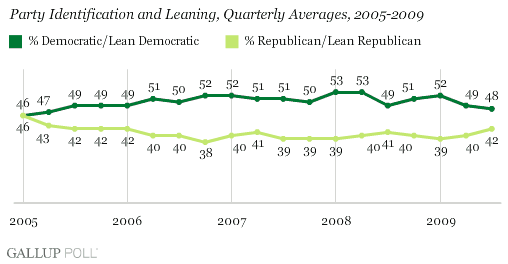PRINCETON, NJ -- In the third quarter of this year, 48% of Americans identified politically as Democrats or said they were independent but leaned to the Democratic Party. At the same time, 42% identified as Republicans or as independents who leaned Republican. That six-point spread in leaned party affiliation is the smallest Gallup has measured since 2005.

These results are based on an average of five Gallup and USA Today/Gallup polls conducted in the third quarter of 2009, encompassing interviews with more than 5,000 U.S. adults. Gallup's Daily tracking survey -- established in 2008 -- has shown a similar narrowing of the party support gap in recent months.
"Since Barack Obama took office as president in January, the Democratic advantage in leaned party identification has shrunk each quarter, from 13 points in the first quarter (52% to 39%) to 9 points in the second quarter (49% to 40%) and 6 points in the most recent quarter (48% to 42%)."
Gallup measures party identification by first asking Americans whether they consider themselves Republicans, Democrats, or independents. Those who identify as independents or say they have no party preference are asked a follow-up question -- whether they lean more to the Republican Party or to the Democratic Party. The figures reported here represent the combined total of identifiers and leaners for each party.
The last time Republicans were this close to Democrats in terms of total party support -- during the second quarter of 2005 -- George W. Bush was in the early months of his second term as president. But the Bush administration suffered a series of setbacks that year, including ongoing difficulty in stabilizing Iraq, a slow response to Hurricane Katrina, and the ultimately withdrawn nomination of Harriet Miers to the Supreme Court, to name a few. Rising gas prices and a struggling economy only added to the problems plaguing the Bush administration during Bush's second term in office.
Bush's job approval rating sank over the course of 2005, from 52% at the start of the year to 43% by late December, including several sub-40% ratings in the fall. By the end of 2006, it had fallen to 35%, and it never again exceeded 38%.
During this time, an increasing number of Americans began to align themselves with the Democratic Party. The Democratic advantage in leaned party ID grew to as large as 14 percentage points in the fourth quarter of 2006 and again in the first quarter of 2008 -- the largest gap in favor of either party since Gallup began regularly measuring leaned party identification in 1991. Democrats maintained a double-digit lead for 11 of 12 quarters between the second quarter of 2006 and the first quarter of 2009. This solid edge in party support helped propel the Democratic Party to major victories in the 2006 and 2008 federal elections.
Since Barack Obama took office as president in January, the Democratic advantage in leaned party identification has shrunk each quarter, from 13 points in the first quarter (52% to 39%) to 9 points in the second quarter (49% to 40%) and 6 points in the most recent quarter (48% to 42%).
As the accompanying table indicates, the Democratic-Republican gap is narrowing because more independents now say they lean to the Republican Party -- there has been no apparent increase in the percentage of Americans who identify as Republicans on the initial party-preference question. Likewise, the percentage of Americans identifying as Democrats has been fairly stable, but fewer independents now say they lean Democratic. Thus, the shifts in party support have come mainly among those with weak party attachments.

Bottom Line
Though Democrats maintain an edge in party support over Republicans, Americans' tendency to identify with or lean toward the Democratic Party is lessening, coming down from the heights it reached near the end of the Bush administration. The changes in party support have been mainly among those who do not have a firm party commitment -- those who initially identify as independents but express a leaning toward either of the major parties.
In fact, Gallup has found that independents are more likely to oppose than support healthcare reform, and to express concerns about increased government spending and the expansion of government power. Thus, the drop in Democratic support is partly a response to concerns about the policies Obama and the Democratic Congress are pursuing.
Whatever the causes, it is important to note that even as Republicans are closing the gap in party support, the percentage of Americans with a firm commitment to the Republican Party -- those who identify themselves as Republicans -- is not increasing.
Survey Methods
Results are based on telephone interviews with 5,090 national adults, aged 18 and older, in five polls conducted between July 1 and Sept. 30, 2009. For results based on the total sample of national adults, one can say with 95% confidence that the maximum margin of sampling error is ±1 percentage point.
Interviews are conducted with respondents on land-line telephones (for respondents with a land-line telephone) and cellular phones (for respondents who are cell-phone only).
In addition to sampling error, question wording and practical difficulties in conducting surveys can introduce error or bias into the findings of public opinion polls.
